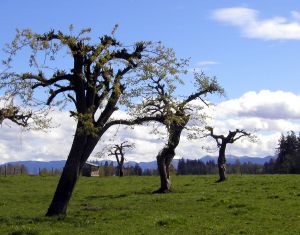Aristocrats of the Prune Orchards
Posted on October 10, 2011
 Most readers of Focus will know that our area was once famous for the production of a particular variety of plum with excellent eating and preserving qualities. It was also said to be of great value in the straw hat trade in Luton and Dunstable where the locally made straw plait was turned into natty ladies and gents headwear.
Most readers of Focus will know that our area was once famous for the production of a particular variety of plum with excellent eating and preserving qualities. It was also said to be of great value in the straw hat trade in Luton and Dunstable where the locally made straw plait was turned into natty ladies and gents headwear.
The local plums - or more correctly their skins were used to make a dye with which to tint the straw hats in a fetching shade of purple fashionable in the late Victorian and Edwardian periods. Eaton Bray, Edlesborough and adjoining parishes were extensively planted with plum orchards and the trade flourished into the 1950s, but since then these orchards have ceased to be managed for fruit production and are, for the most part either used for grazing or are disused and reverting to scrub.
But they still have a great value for wildlife and support a range of characteristic fungi, lichens, plants, insects, birds and mammals. And some of the old fruit trees support species which are not found anywhere else.
In the depths of last winter's snow and ice some of you may have noticed some odd looking characters, well swathed in weather stopping garments, peering through hedges or over gates, or taking a close interest in any gnarled and ancient orchard trees which could be reached by public footpath or bridle way. They looked odd because they were carrying a heavy load of sample jars, tape measures, ordnance survey maps, assorted paperwork and other gubbins necessary for their business. They were volunteers carrying out an initial survey of the condition of local orchards and their trees on behalf of Natural England and the People's Trust for Endangered Species. If you own or live close to an orchard they may have knocked on your door, or left an information pack about the work.
More specifically they were looking for trees of an age and condition suitable for one of Britain's rarest creatures: a beetle known as the Noble Chafer. This beautiful beetle (see picture on page 73) depends on dead and decaying wood and is found only in traditional orchards, large numbers of which are being destroyed for agriculture or development, or are disappearing through neglect.
The Noble Chafer is a handsome creature. Adults are about 2cm long and a striking, iridescent green in colour. They survive for only 4 to 6 weeks and the very fortunate who live in the areas where they breed may see them on the wing, or visiting flowers such as hogweed, on hot, sunny days in July and August.
They mate at this time and the females lay eggs in the decaying wood of old fruit trees. They prefer orchards with mature trees, 50 to 80 years old – just the sort which are vulnerable to clearance or removal. The larvae feed on the rotting wood, taking two years to develop into adults. During this time the larvae produce characteristic droppings called frass. This often accumulates in the hollows and crevices of the old trees and is an indicator of the presence of the Noble Chafer.
Until very recently the Noble Chafer was believed to survive only in a few orchards in Gloucestershire, Herefordshire and Worcestershire, south Oxfordshire and parts of the New Forest. But no longer! For, as a result of the findings of the initial survey, and a very detailed follow up investigation by specialists in the field, the Noble Chafer has been discovered in an old orchard in Edlesborough. And it may be in others in this area. This is sensational news and has caused great excitement amongst naturalists and wildlife organisations.
If you own, lease or rent an old orchard and are interested in finding out if the Noble Chafer has made its home there you can ask the People's Trust for Endangered Species to send an expert to carry out a survey. Or you can search for "frass" yourself. Collect a handful of the wood mould that has accumulated in a hole or crevice in an old fruit tree. This will be fine, woody material, but it may contain frass, which are lozenge shaped pellets about 3mm long (see picture on page 73). Should you also find larvae in the mould sample, return them carefully to the hole or crevice – but take a photograph if you can. If you find frass or larvae please report your find to the People's Trust for Endangered Species (PTES).
Also contact the PTES if you would like to know more about, or take part in the work to map, investigate and record the condition of old orchards and their wildlife. You can do this by telephone: 020 7498 4533; by e mail: [email protected] ; or by writing to: People's Trust for Endangered Species, 15 Cloisters House, 8 Battersea Park Road, London. SW8 4BG.
Source: Focus, October 2011
Reader Comments
There are currently no comments about this article.